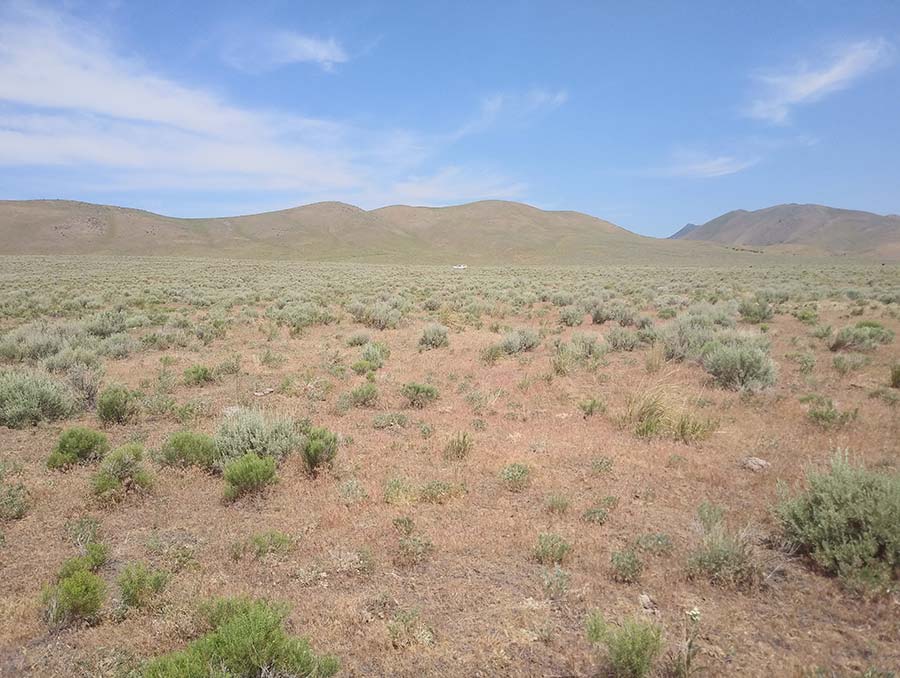With wildfires raging in the West, two University of Nevada, Reno researchers are doing further studies on two herbicides known to reduce cheatgrass, a fine fuel that ignites readily. The researchers are looking at the herbicides’ effects on more desired plant species that often grow with cheatgrass, including native bunchgrasses and forbs, or wildflowers, in order to give land managers the information they need to weigh the costs and benefits of using these herbicides, Plateau and Rejuvra. This work will hopefully give managers a better tool to reduce flammable cheatgrass while allowing desired forbs and bunchgrasses to increase.
The work is part of the University’s College of Agriculture, Biotechnology & Natural Resources, and its Extension and Experiment Station units. Paul Meiman, associate professor and Extension specialist, is working with Brad Schultz, professor and Extension educator for Humboldt County, to test the use of the herbicides. Plateau is an herbicide using the chemical imazapic that has been around for a while and commonly suppresses cheatgrass for one or two years. Rejuvra is a newer herbicide using indaziflam, which has already been shown to suppress cheatgrass for multiple years in other Western states
Neither of these herbicides used to target cheatgrass negatively affect established sagebrush plants. However, potential impacts to other plants in the community, especially native forbs, are less known. While eliminating cheatgrass growth is the goal, Meiman and Schultz want to ensure other parts of the plant community are not adversely affected and may have the opportunity to increase if the right weather events occur when cheatgrass or other annual grasses decline. Another important component of the study is to determine whether or not the herbicides are able to reduce the amount of cheatgrass underneath sagebrush canopies.
“Cheatgrass invasion is one of the biggest challenges facing natural resource management and managers in the West right now, especially in our part of Nevada,” Meiman said. “Even if we see some unwanted effects from the herbicides with this study, they may be outweighed by the opportunity to break the cycle of recurring fires that has converted thousands upon thousands of acres of rangeland to plant communities dominated by cheatgrass. These are not easy decisions. Our hope is to provide additional information to landowners and land managers about tools available to manage cheatgrass.”
The study, which is being conducted as part of the College’s Experiment Station unit and is planned to begin later this summer, is taking place over the course of three years in collaboration with the U.S. Fish & Wildlife Service; the Nevada Department of Wildlife; and Bayer, the maker of Rejuvra. Using land provided by Nevada Gold Mines, Meiman and Schultz are conducting this work on a large-scale using 20- to 40-acre test plots and aerially applying the herbicides. The plots will be sprayed with either Rejuvra, Plateau or a mixture of both to determine the most effective strategy for combating cheatgrass growth and abundance with the least impact to native plants. After the first application, the researchers will track the effects of the herbicides over the next couple of years.
“If this herbicide treatment proves effective, it provides an additional tool for managers to reduce cheatgrass on sites where native plants are being pushed out, but still maintain sufficient presence to provide seed for populations to expand,” Schultz said. “It has the opportunity to give native plants at risk of transitioning to primarily annual grasses, a three-to-six-year window to increase their abundance over time and, eventually, out-compete the cheatgrass in determining future vegetation change.”
Most of the past research on these herbicides has occurred elsewhere in the West in somewhat different environments than Nevada. Meiman and Schulz are extending that research to measure the impact in Nevada’s climate and ecosystems. Past work has also been done with other chemicals to try to reduce cheatgrass in the state, but this new research will provide important additional information to managers about where these herbicide treatments can be effective in reducing cheatgrass and encouraging growth of beneficial plant communities.















